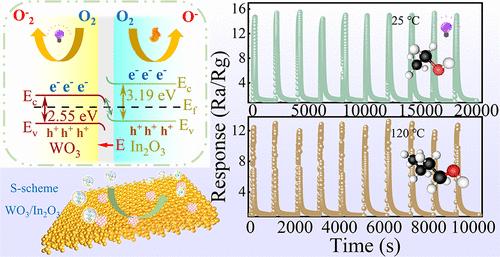Constructing S-Scheme Charge Migration in a Self-Assembled In2O3/WO3 Heterojunction for Photothermal-Driven Dual-Gas Detection
IF 9.1
1区 化学
Q1 CHEMISTRY, ANALYTICAL
引用次数: 0
Abstract
Increased safe and environmental awareness in production processes necessitates an ever-growing demand for efficient detection of ethanol/n-butanol/diesel fuel blends (clean energy) in rapid, real time. However, the forces between multiplexed organic molecules in complex environments induce a decrease in the flash point, thus requiring sensors with high selectivity and low-temperature detection capabilities. In this study, an In2O3/WO3 multilevel heterojunction is assembled by utilizing the electrostatic interaction between the hydroxyl group of In(OH)3 and WS2. The material achieves dual detection of ethanol and n-butanol under the excitation of light and temperature fields. It also possesses fast response/recovery times, excellent selectivity, and good long-term stability. The WO3 has a defect-rich (002) exposed surface in the In2O3/WO3 heterojunction, and the special electronic structure of the heterojunction induces carrier migration at the S-scheme heterointerface under photothermal activation, which promotes the generation of more reactive oxygen species (O2–, O–) from the sensing material. The special chemical reaction of the sensor between oxygen anions and the target gas at room temperature (RT) and 120 °C is the basis for the realization of dual-selective detection of ethanol and n-butanol. The sensing mechanism of the WO3/In2O3 heterojunction for ethanol/n-butanol has been systematically investigated based on energy band structure analysis and in situ Raman spectroscopic characterization. This work focuses on the potential of metal oxide-based S-scheme heterojunctions for high-performance gas sensor applications.

在自组装In2O3/WO3异质结中构建S-Scheme电荷迁移用于光热驱动双气体检测
生产过程中安全和环保意识的提高,使得对乙醇/正丁醇/柴油燃料混合物(清洁能源)快速、实时有效检测的需求不断增长。然而,在复杂的环境中,多路有机分子之间的作用力会导致闪点的降低,因此需要具有高选择性和低温检测能力的传感器。在本研究中,利用In(OH)3羟基与WS2之间的静电相互作用,组装了In2O3/WO3多层异质结。该材料在光场和温度场的激发下实现了乙醇和正丁醇的双重检测。它还具有快速的响应/恢复时间,优异的选择性和良好的长期稳定性。在In2O3/WO3异质结中,WO3具有富缺陷(002)的暴露表面,并且异质结的特殊电子结构在光热活化下诱导载流子在s型异质界面迁移,促进了传感材料中活性氧(O2 -, O -)的产生。传感器氧阴离子与目标气体在室温和120℃下的特殊化学反应是实现乙醇和正丁醇双选择性检测的基础。基于能带结构分析和原位拉曼光谱表征,系统研究了WO3/In2O3异质结对乙醇/正丁醇的传感机理。这项工作的重点是基于金属氧化物的s -方案异质结在高性能气体传感器应用中的潜力。
本文章由计算机程序翻译,如有差异,请以英文原文为准。
求助全文
约1分钟内获得全文
求助全文
来源期刊

ACS Sensors
Chemical Engineering-Bioengineering
CiteScore
14.50
自引率
3.40%
发文量
372
期刊介绍:
ACS Sensors is a peer-reviewed research journal that focuses on the dissemination of new and original knowledge in the field of sensor science, particularly those that selectively sense chemical or biological species or processes. The journal covers a broad range of topics, including but not limited to biosensors, chemical sensors, gas sensors, intracellular sensors, single molecule sensors, cell chips, and microfluidic devices. It aims to publish articles that address conceptual advances in sensing technology applicable to various types of analytes or application papers that report on the use of existing sensing concepts in new ways or for new analytes.
 求助内容:
求助内容: 应助结果提醒方式:
应助结果提醒方式:


